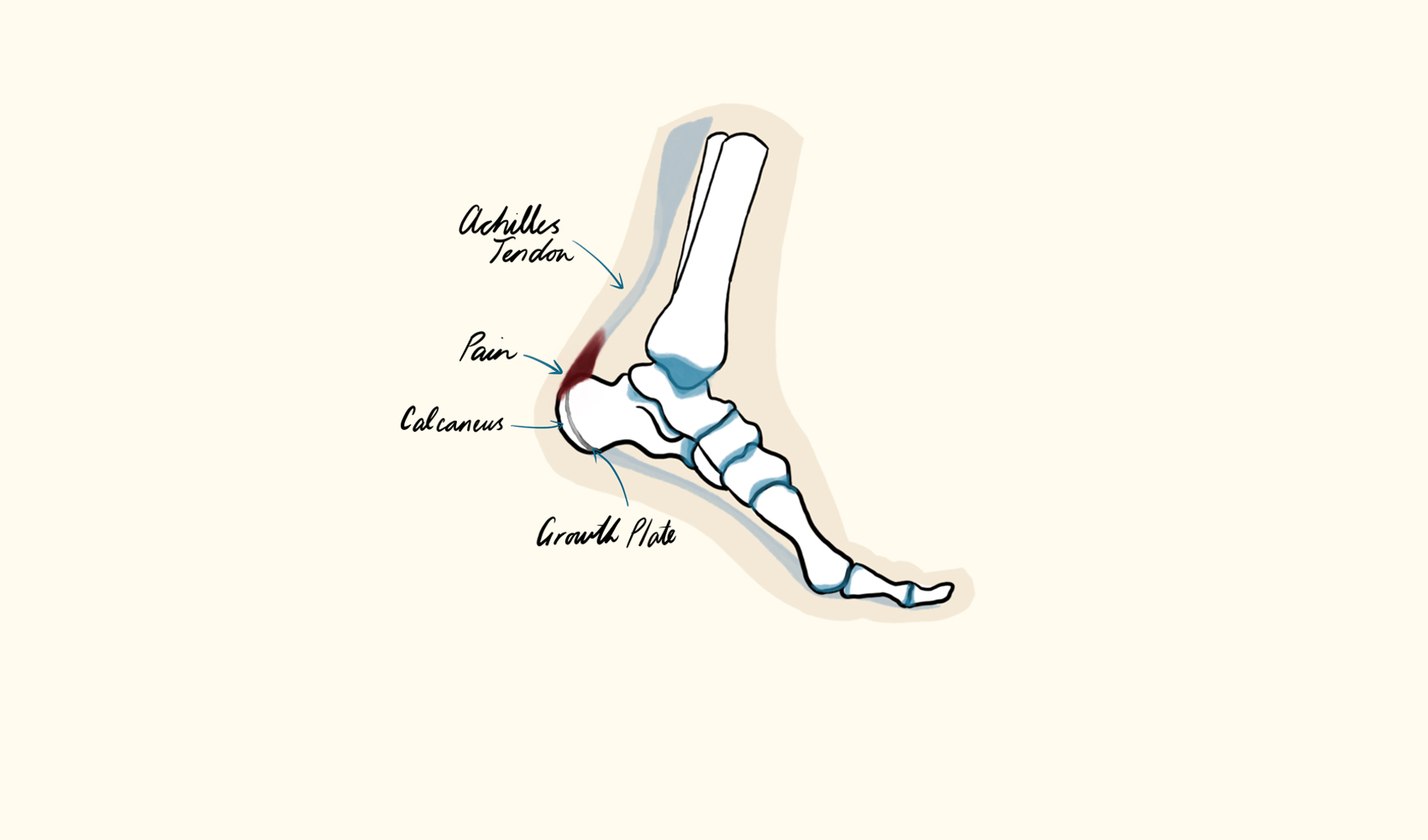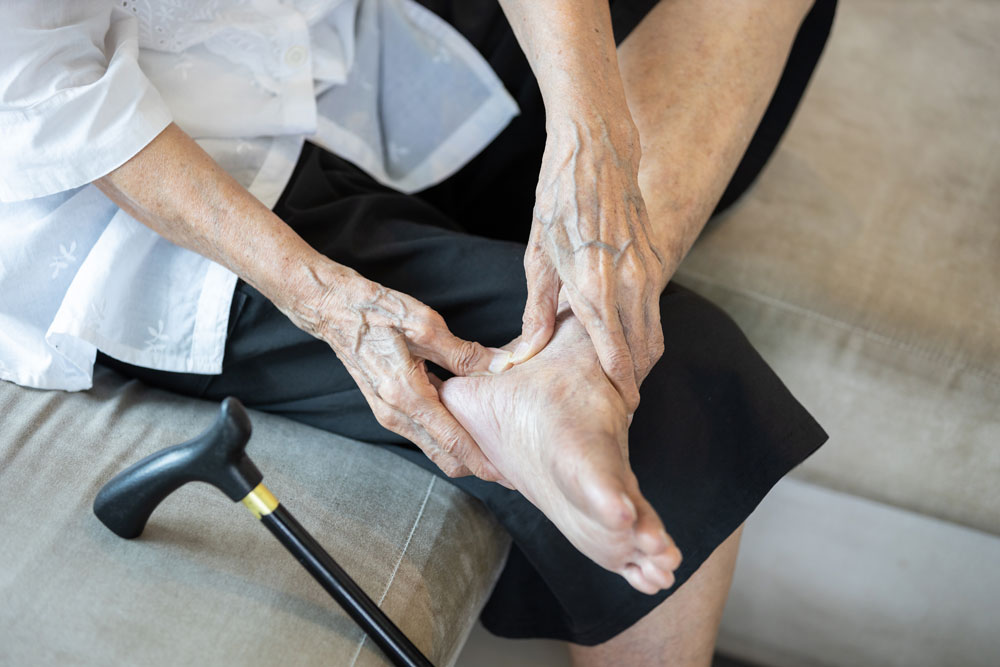Sever’s Disease
Sever’s disease, Severs and Calcaneal Apophysitis are all terms used to define heel pain experienced by children and young adolescents. It’s important to note that Sever’s disease is technically not a ‘disease’, but a common cause of heel pain in younger people which can occur in one or both feet.

What is Sever’s Disease?
Sever’s Disease is a fancy name for heel pain experienced by your child or teen. Children and teens often feel Sever’s heel pain when they are having a big growth spurt. It is quite common for your child’s foot to grow faster than their Achilles tendon (which is joined to the heel bone and goes up towards the calf). When the tendon hasn’t lengthened enough to keep up with the growing foot size, your child can feel tension, pain and swelling at the heel.
Child heel pain is very different to that experienced by adults. While adult heel pain will often subside after walking, paediatric heel pain tends not to improve in this same manner. In most cases, walking, running and vigorous exercise will actually make the pain worse.
So why can children and teenagers’ heels hurt?
There is a growth plate at the end of the heel which, as the name suggests, adds new bone as children grow. While active, this growth plate feels more like cartilage (similar to the tip of your nose or ears) and is therefore bendable and more vulnerable to excessive strain.
Generally, the heel bone and feet are one of the body’s first parts to reach full adult size as a child / teenager matures and will often grow faster than the muscles, tendons and ligaments in the surrounding area.
With Sever’s disease, the Achilles tendon hasn’t lengthened at the same rate as the heel bone. This can lead to tension, pain and swelling at the point where the Achilles tendon attaches to the growing part of the heel. With this excessive irritation, it can also cause inflammation and bruising within the growth plate. In some very severe cases, the blood supply to the bone can be interrupted causing an area of the bone to die (avascular necrosis).
Ages most likely affected by heel pain
Growth spurts are closely linked with Sever’s disease and therefore are more prevalent for girls and boys between the ages of 8 – 15 years. Although experienced by many, it is commonly seen in boys during the rapid changes that occurs over the course of puberty. The good news is that once the heel has fully grown, Sever’s disease no longer becomes a concern as the growth plate turns to solid bone.
Symptoms of Sever’s Disease
Symptoms of Sever’s disease tend to be quite debilitating and impact freedom of movement for the child or teen. It can be experienced in both heels evenly, one heel more than the other, or, in only one heel. Regardless of this, common symptoms include:
- Sharp or aching pain at the back of one or both heels
- Redness and swelling in the heel
- Stiff feet when first waking in the morning
- Abnormal tightness through the back of the leg and down towards the heel
- Limping
- Walking on tiptoes
- Pain when the heel is squeezed on both sides
- Gradually increasing pain over extended periods of time
- Pain in heel worsening when physically active, playing sport or prolonged standing
- Heel pain becoming more intense when barefoot or wearing ill fitted footwear
- Pain that lessons with rest and ice but returns with physical activity
What Causes Heel Pain in Children and Teens?
There are many varied factors that can cause or exacerbate increased strain on the Achilles tendons, calves and heel which can lead to pain. These include but are not limited to:
Physical Activity
Sporting activity is seen as one of the most common causes of heel pain for children and teens. This is especially true for sports that involve repetitive running and jumping on hard surfaces as these put additional strain on already overstretched tendons.
Here is a list of some of the sports that may exacerbate heel pain when a teen or child is going through a growth spurt:
- Soccer
- Basketball
- Netball
- AFL
- Rugby League
- Hockey
- Rugby Union
- Tennis
- Track
- Gymnastics
- Ballet
- Baseball
- Skateboarding
- Rope skipping
Footwear
Poorly fitted footwear, wearing thongs/flip flops, being barefoot on hard surfaces and low-heeled shoes can contribute to Severs. Most commonly however, sport specific footwear like soccer boots can cause or exacerbate heel pain. Shoes like cleats often have a lower pitch point. This means the difference in the height between the heel and forefoot varies greatly to more supportive joggers.
Obesity
Obesity has become more common for Australian youth with the generational shift in nutrition and reduced physical activity for some young people. As a result, Severs can become an issue if the skeletal system is required to bear additional weight when walking and exercising. This is mainly due to the increased force directed into the feet.
Biomechanics
Known as pronation, flat feet or poor foot function, a foot that rolls in can cause excessive strain on the Achilles tendon. This is because the increased tension/twisting on the Achilles inflames the insertion point to the growth plate of the heel.
Sever’s Disease Treatment
In many instances we like to teach our children to be resilient, asking them to push through discomfort to achieve an end goal. This can be more common with athletic children participating in competitive sports. When it comes to heel pain, however, we advise to never play through the pain or dismiss it as ‘growing pains’. This is because if Sever’s disease is left untreated, it can lead to difficulty walking, take longer to heal and worsen over time.
Without proper diagnosis, intervention and activity modification, it is extremely unlikely to resolve itself. Worse still, ignoring the symptoms can lead to more severe injury and chronic pain.
As a crucial note, not all child and teen heel pain is Sever’s disease. For example, the growth plates in some teens may have completely fused. In these instances, the pain could be caused by plantar fasciitis, bursitis, Achilles tendonitis, juvenile rheumatoid arthritis, bone bruises, posterior ankle impingement, infection, fractures and in rare instances tumours. For these reasons, it’s incredibly important to have paediatric heel pain properly assessed and diagnosed by a trained podiatrist.
At home care for Sever’s Disease
The good news is that although serious, child and teen heel pain caused by Sever’s Disease is a very common ailment which will resolve quickly when given the proper attention and care.
Once accurately diagnosed, at home care can include the simple RICE Strategy:
- Rest: Give the heels and feet a break by stopping all high intensity activities or standing for prolonged periods
- Ice: Apply ice for 20 minutes at a time. Repeat this is much as 4 – 8 times a day
- Compression: If there is excessive swelling – compress with an elastic bandage or compression stocking
- Elevate: Raise the heel/s above the heart level using a cushion
Medication
Always consult a podiatrist or doctor first, but pain-relieving medication such as ibuprofen may help ease the pain in some cases. This should always be combined with corrective treatment and activity modification.
Time and Maintenance
With proper diagnosis and treatment, the heel pain will usually ease in one to two weeks. Be vigilant when reintroducing physical activity though, as it can be supportive to engage in lower impact sports such as swimming, bicycling and even roller skating initially. Depending on the circumstances, support the child/teen to wear supportive footwear, stretch before and after exercise and if needed, lose weight.
It’s important to understand that Sever’s Disease can re-present in the future due to a sudden increase in physical activity, growth spurts or changing footwear. That said, it’s important not to assume future heal pain is also Severs as it may be an entirely different condition. In these instances, check in with your podiatrist for a proper diagnosis.
Specialised Sever’s Disease Treatment from the podiatrist Byron Bay locals trust
At Northern Rivers Podiatry we will usually perform a comprehensive assessment and diagnosis including:
- Collecting a detailed history
- Analysing the gait, muscles, tendon, ligaments and joint
- Biomechanical evaluation
- Video gait analysis
- Footwear recommendation
- 3D digital scanning of feet
- Comprehensive custom orthotic prescription
- Physical therapy and exercises prescribed
- Activity modification and recommendations for rest and recuperation
- Education on how to self-manage symptoms
- Shoe modification with padding, wedges and heel lifts
- Weight management to alleviate excessive weight bearing in some cases
- Medication such as over the counter pain killers to reduce discomfort
- Imaging for further evaluation if necessary
Contact Us
"*" indicates required fields









